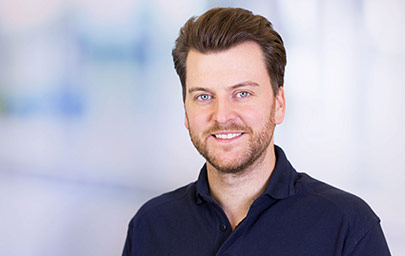For the current edition of our newsletter we put a few questions to the Leader of our Process & Automation Team, Matthias Bach, about his job and his time at Steinemann. Read here what he has to say about himself and his daily routine at Steinemann.
Editors: First we have a few questions about you …

If you could meet any famous person, dead or alive, who would that be and why?
Helmut Kohl. At the time in which I became interested in politics he was omnipresent. But I often think today that this man has lived through incredible things. He has spoken with people who will always be a topic of discussion in history lessons. He governed Germany during a formative time for my home country, one which paved the way for the future.
If your life was made into a film, which actor would play you?
George Clooney would surely be the best choice 😀
What job did your parents envision you having?
Carpenter.
And how did you professional career pan out?
I first completed an pipe organ builder’s apprenticeship. After that I studied the wood science in Hamburg. I wrote my Bachelor’s thesis in Sweden and my Master’s thesis at Steinemann in Switzerland. After that I stayed at Steinemann. I first worked here as a process engineer. My primary area of responsibility was developing new products as well as conducting basic research for the sanding process. In addition, I was able to impart the knowledge I had acquired to customers through training sessions or audits.
You have just recently been promoted to Head of Process & Automation. What does a typical work day look like for you?
It is exciting to accompany my development project BQC into the marketing process. We’re no longer racking our brains about algorithms, we’re looking to optimise communication with customers who have already purchased a BQC in such a way that it quickly becomes clear, who has to do what on our end. The BQC isn’t just a new Steinemann product; with this product, we are really getting to the heart of “Industry 4.0” or the “Industrial Internet of Things” for the first time. This suddenly raises new questions for a mechanical engineer.
What do you like most about your job or which part do you find the most enjoyable?
It is very instructive and exciting to start a product’s development from scratch and later to bring it onto the market. Alongside research and development, my job also enables me to have contact with our customers. This is important to me and I find it very enjoyable.
What has made the biggest impression on you during your time at Steinemann?
Personally speaking, during my time at Steinemann I became a father to two wonderful children. Professionally speaking, familiarising myself with the Swiss mindset made a real impression on me.
I appreciate the fact that people here deal with one another honestly and overcome stressful situations in a calm manner. My colleagues never stand still and are always searching for new products and opportunities for optimising and simplifying the sanding process for our customers.
If you had to choose a favourite project, which would it be and why?
My BQC, of course.
What challenges and opportunities do you envisage for the sanding line/sanding process in the context of the Industrial Internet of Things?
It is abundantly clear that the challenge lies in the substrate. Every customer panel is different. This difference is dependent on the technology used but also on the raw materials, such as the wood type and the formula for the resin. This makes a global standardisation of the sanding process unbelievably complicated.
The biggest opportunity is the simplification of the sanding process through gathering experience. If it’s possible for us to relate different sanding parameters to one another and to analyse these, this will then give us a greater understanding of additional connections. Ultimately, we want make things easier for the machine operator and at the same time ensure that the quality of our customer’s panels continues to increase. We have ascertained that, across the world, the surface quality of sanded wooden composite panels is becoming increasingly significant.
In your previous position as a technology expert, you didn’t just visit customers when everything was running smoothly. What is one problem that you regularly encounter and what is the solution?
Chatter marks. Sometimes the solution is simple.
1. The machine must be well maintained and serviced
2. The use of combination sanding belts for fine sanding units should be avoided
3. Always leave a tolerance of at least 0.1 mm for finishing
